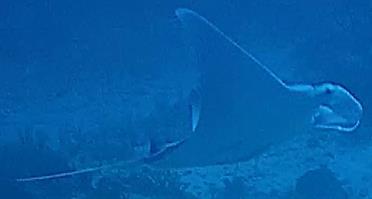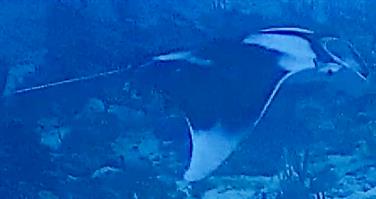





Mobula cf birostris
| Ecological Descriptors |
||||
| Habitat | Size | Diet | Behaviour | Sex |
| Pel | Across wing tips to 6m+ | Pla | I, Sh | F |
Notes:
1. Mantas and Devil Rays have been regrouped into the single Genus Mobula and the Genus Manta discarded (Marshall 2009)
2. The Caribbean Manta is a putative species, separate to the Giant Manta (M. bistrosis), but not yet fully described. Marshall (2009) has tentatively proposed M. giorna as a name once DNA evidence backs up the morphological and meristic differences.
According to Marshall (2009), "differences exist between Manta sp. cf birostris and M. birostris including dissimilar denticle
morphology and distribution, intermediary dentition and, most noticeably, differences in dorsal and ventral colouration. While Manta sp. cf birostris occurs in sympatry with M. birostris in parts of the Atlantic and Caribbean, there is some evidence that differences in fine-scale habitat selection and seasonal habitat use may occur in some locations."
Description:
Fish dorso-ventrally flattened with triangular wings, with dark back (black to dark brown) and white underside. Head relatively wide, with a pair of large, paddle-shaped cephalic flaps (cf straight, pointed flaps in Devil Rays). Slender whip-like tail.
The mouth is whitish/cream (cf dark in Giant Manta), with or without whitish patches on shoulders as animal can rapidly change degree of display, but if they are present shoulder patches are oval with a short rear facing hook on anterio-distal side, (in the Giant Manta these are less oval with a longer hook). The front edge of shoulder patch runs from the spiracle to a line parallel to edge of top jaw. The underside white, with dark grey to black spots and patches on rear of pectoral fins and behind the last gill slits, no spots centrally between gill slits. Dark to pale rear margin on underside of wings.
Ecology
Oceanic and coastal pelagic to depths of ~200m (650ft), especially in areas with upwelling water. In Caribbean co-occurs with M. bistrosis.
Feeds on plankton and possibly small fish, employing the cephalic scoops to channel water into mouth, feeding either singly or in groups. Leaps out the water mainly in spring and autumn, possibly as part of mating behaviour
Life Cycle:
Presumed, but not confirmed, to be similar to Giant Manta (M. bistrosis):
Exhibit ovoviparity (aplacental viviparity), with embryos feeding initially on yolk, then receiving additional nourishment from the mother by indirect absorption of uterine fluid enriched with mucus, fat or protein through specialised structures. Bears up to 2 young reach 50 inches in disc width and weigh 20 lbs. or more. Parturition occurs in relatively shallow water where the young remain for a few years prior to expanding their range offshore
The mating behavior of manta rays based on observations off Ogasawara Islands, Japan, in the following sequence: 1) 'chasing', the male rapidly follows behind the tail of the female and attacks her several times; 2) 'nipping', the male nips the tip of the pectoral fin of the female and then moves to the ventral surface of the female; 3) 'copulating', the male inserts a clasper into the cloacaof the female and copulates abdomen-to-abdomen, up to 123 seconds; 4) 'post-copulating'; 5) 'separating'.
1. Mantas and Devil Rays have been regrouped into the single Genus Mobula and the Genus Manta discarded (Marshall 2009)
2. The Caribbean Manta is a putative species, separate to the Giant Manta (M. bistrosis), but not yet fully described. Marshall (2009) has tentatively proposed M. giorna as a name once DNA evidence backs up the morphological and meristic differences.
According to Marshall (2009), "differences exist between Manta sp. cf birostris and M. birostris including dissimilar denticle
morphology and distribution, intermediary dentition and, most noticeably, differences in dorsal and ventral colouration. While Manta sp. cf birostris occurs in sympatry with M. birostris in parts of the Atlantic and Caribbean, there is some evidence that differences in fine-scale habitat selection and seasonal habitat use may occur in some locations."
Description:
Fish dorso-ventrally flattened with triangular wings, with dark back (black to dark brown) and white underside. Head relatively wide, with a pair of large, paddle-shaped cephalic flaps (cf straight, pointed flaps in Devil Rays). Slender whip-like tail.
The mouth is whitish/cream (cf dark in Giant Manta), with or without whitish patches on shoulders as animal can rapidly change degree of display, but if they are present shoulder patches are oval with a short rear facing hook on anterio-distal side, (in the Giant Manta these are less oval with a longer hook). The front edge of shoulder patch runs from the spiracle to a line parallel to edge of top jaw. The underside white, with dark grey to black spots and patches on rear of pectoral fins and behind the last gill slits, no spots centrally between gill slits. Dark to pale rear margin on underside of wings.
Ecology
Oceanic and coastal pelagic to depths of ~200m (650ft), especially in areas with upwelling water. In Caribbean co-occurs with M. bistrosis.
Feeds on plankton and possibly small fish, employing the cephalic scoops to channel water into mouth, feeding either singly or in groups. Leaps out the water mainly in spring and autumn, possibly as part of mating behaviour
Life Cycle:
Presumed, but not confirmed, to be similar to Giant Manta (M. bistrosis):
Exhibit ovoviparity (aplacental viviparity), with embryos feeding initially on yolk, then receiving additional nourishment from the mother by indirect absorption of uterine fluid enriched with mucus, fat or protein through specialised structures. Bears up to 2 young reach 50 inches in disc width and weigh 20 lbs. or more. Parturition occurs in relatively shallow water where the young remain for a few years prior to expanding their range offshore
The mating behavior of manta rays based on observations off Ogasawara Islands, Japan, in the following sequence: 1) 'chasing', the male rapidly follows behind the tail of the female and attacks her several times; 2) 'nipping', the male nips the tip of the pectoral fin of the female and then moves to the ventral surface of the female; 3) 'copulating', the male inserts a clasper into the cloacaof the female and copulates abdomen-to-abdomen, up to 123 seconds; 4) 'post-copulating'; 5) 'separating'.
Caribbean Manta




Synonym:
Atlantic Manta
Atlantic Manta

Caribbean Manta
Caribbean Manta

(C) Charles Sade/ Antigua Scuba School
(C) Charles Sade/ Antigua Scuba School
(C) Charles Sade/ Antigua Scuba School

603
604
604

